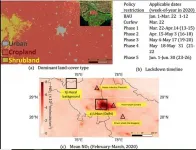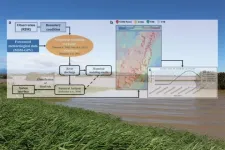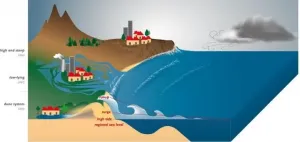Separating natural and man-made pollutants in the air
What COVID-19's lockdown to prevent infection taught us
2021-06-18
(Press-News.org) COVID-19 has changed the world in unimaginable ways. Some have even been positive, with new vaccines developed in record time. Even the extraordinary lockdowns, which have had severe effects on movement and commerce, have had beneficial effects on the environment and therefore, ironically, on health. Studies from all around the world, including China, Europe and India, have found major drops in the level of air pollution. However, to fully understand the impact of anthropogenic causes, it is important to separate them from natural events in the atmosphere like wind flow.
To demonstrate this point, a new study by researchers at the Research Institute for Humanity and Nature, Japan, uses satellite data and mathematical modeling to explain just how great the lockdown effect on nitrogen oxides has been in Delhi, India, one of the world's most polluted cities, and its surrounding area. This study was carried out under the activity named "Mission DELHIS (Detection of Emission Change of air pollutants: Human Impact Studies)" as a part of RIHN project, Aakash (meaning "Sky" in Hindi, originated from sanskrit) (https://www.chikyu.ac.jp/rihn_e/covid-19/topics.html#topics6).
"Nitrogen oxides are good chemical tracers for testing model hypothesis, because besides their health effects, they have a short lifetime. Therefore, it is unlikely wind will bring nitrogen oxides from far away." explains Professor Sachiko Hayashida, who led the study.
Nitrogen oxides naturally change due to dynamic and photochemical conditions in the atmosphere, and are emitted from the Earth's surface by both natural and anthropogenic activities. Therefore, Hayashida argues, looking simply at their concentration levels in the atmosphere provides only a crude impression of man-made contributions.
"COVID-19 pandemic has given us an opportunity of social experiment, when we can discriminate the anthropogenic effects on nitrogen oxides from the natural ones caused by atmospheric conditions and natural emissions, because only anthropogenic emissions decreased due to the lockdown. These confounders affect policy to control air quality" she says.
Strict lockdown was enforced in Delhi for two months in 2020, from the end of March to the end of May. This period coincides with the transition in atmospheric conditions, such as actinic flux, from low in spring to high in early summer, and also from stagnant winds to high ventilation across the entire northern India region.
The researchers analyzed seasonal and inter-annual changes using multi-year satellite data to predict what the levels would be had there been no lockdown. They estimated top-down emissions using a steady-state continuity equation. The study's findings clearly show that the natural conditions could not explain the dramatic drop in 2020 nitrogen oxide levels. Not even close.
"Our calculations suggested that 72% of nitrogen oxides emissions in urban centres are the resulted solely from traffic and factories," said Hayashida.
Interestingly, the levels recovered after the lockdown more quickly in rural levels than they did in urban ones, an effect attributed to agricultural activities, such as crop-residue burning, which resumed almost immediately. Unlike factories, the agricultural activities continued, albeit at a lesser pace, during the lockdown, which was less stringent on agriculture.
Hayashida says that her team's approach should have an impact on how we study harmful chemical species emitted to the atmosphere.
"Our findings show the importance of analyzing top-down emissions and not just atmospheric concentrations. We expect our approach to guide effective policy on air pollution," she said.
INFORMATION:
[Attachments] See images for this press release:

ELSE PRESS RELEASES FROM THIS DATE:
2021-06-18
Identifying the causes of human neurodegenerative diseases is a global research priority, warranting frequent reviews of the accumulating knowledge. In doing just that, biologists from the Plant Physiology Laboratory at the University of Guam and neuroscientists from the Experimental Medicine Program at The University of British Columbia have published an update on the reputed environmental toxins that have been suspected of being involved in mammal neurodegeneration. Their summary was published in April in the book Spectrums of Amyotrophic Lateral Sclerosis, which is available online ...
2021-06-18
According to a recent Finnish study, higher levels of moderate and vigorous physical activity can curb arterial stiffening already in childhood. However, sedentary time or aerobic fitness were not linked to arterial health. The results, based on the ongoing Physical Activity and Nutrition in Children (PANIC) Study conducted at the University of Eastern Finland, were published in the Journal of Sports Sciences. The study was made in collaboration among researchers from the University of Jyväskylä, University of Eastern Finland, the Norwegian School of Sport sciences, and the University of Cambridge.
Arterial stiffening predisposes to heart diseases, ...
2021-06-18
Tokyo, Japan - In Japan, thousands of homes and businesses and hundreds of lives have been lost to typhoons. But now, researchers have revealed that a new flood forecasting system could provide earlier flood warnings, giving people more time to prepare or evacuate, and potentially saving lives.
In a study published this month in Scientific Reports, researchers from The University of Tokyo Institute of Industrial Science have shown that a recently developed flood forecasting system provides much earlier advance warnings of extreme flooding events than current systems. ...
2021-06-18
Germany is a hotspot for dragonflies and damselflies (Odonata) species in Europe, owing to the range of habitats and climates that it provides. While many recent and mostly small-scale studies suggest long-term declines of insect populations in different parts of Europe, studies of freshwater insects - including dragonflies and damselflies - suggest that some species have increased in occurrence. Researchers of iDiv, FSU and UFZ have now provided a nationwide analysis of the occurrence and distribution of dragonflies and damselflies in Germany between 1980 and 2016. For this, they analysed over 1 million occurrence records on 77 species from different regional ...
2021-06-18
The population on Earth is increasingly growing and people are expected to live longer in the future. Thus, better and more reliable therapies to treat human diseases such as Alzheimer's and cardiovascular diseases are crucial. To cope with the challenge of ensuring healthy ageing, a group of international scientists investigated the potential of biosynthesising several polyamines and polyamines analogues with already known functionalities in treating and preventing age-related diseases.
One of the most interesting molecules to study was spermidine, which is a natural product already present in people's blood and an inducer of autophagy that is an essential cellular process for clearing damaged proteins, e.g., misfolded proteins ...
2021-06-18
URBANA, Ill. - For the most accurate accounting of a product's environmental impact, scientists look at the product's entire life cycle, from cradle to grave. It's a grand calculation known as a life cycle assessment (LCA), and greenhouse gas emissions are a key component.
For corn ethanol, most greenhouse gas emissions can be mapped to the fuel's production, transportation, and combustion, but a large portion of the greenhouse gas calculation can be traced right back to the farm. Because of privacy concerns, however, scientists can't access individual farm management decisions such as fertilizer type and rate.
Nitrogen fertilizer data are an important piece of the calculation because a portion ...
2021-06-18
A decade-long study of the most common forearm fracture in older adults revealed that personalized medicine catering to a patient's individual needs and environment, not age or X-rays, should guide treatment options.
Led by a Michigan Medicine physician, the research team examined treatment outcomes over two years for patients who fractured their distal radius, the larger of two bones in the forearm. They found no one-size-fits all method for treating the fracture, which more than 85,000 Medicare beneficiaries sustain annually.
"Traditionally, surgeons look at these broken bones on X-rays, and they have to assess various ways of fixing it based off fracture anatomy and patient age," said Kevin Chung, M.D., study lead and Charles B. G. De ...
2021-06-18
By combining satellite data and digital models, the researchers have shown that coastal overtopping, and consequently the risk of flooding, is set to further accelerate over the 21st century, by up to 50-fold under a high emission global warming scenario, especially in the tropics. This increase is principally caused by a combination of sea level rise and ocean waves.
Low-lying coastal regions host nearly 10% of the world's population. In addition to ongoing erosion and rising sea levels, these areas and their unique ecosystems are facing destructive hazards, including episodic flooding due to overtopping of natural/artificial protection, as in the case of Hurricane Katrina, ...
2021-06-18
Scientists from the Walter Reed Army Institute of Research and Naval Medical Research Center partnered with researchers at the University of Pennsylvania and Acuitas Therapeutics to develop a novel vaccine based on mRNA technology that protects against malaria in animal models, publishing their findings in npj Vaccines.
In 2019, there were an estimated 229 million cases of malaria and 409,000 deaths globally, creating an extraordinary cost in terms of human morbidity, mortality, economic burden, and regional social stability. Worldwide, Plasmodium falciparum is the parasite species which ...
2021-06-18
A staged alert system, designed by scientists and public health officials to guide local policies, helped one city prevent hospital surges and long lockdowns, according to new research published in the journal Nature Communications.
In a new study led by The University of Texas at Austin COVID-19 Modeling Consortium in collaboration with Northwestern University, researchers describe the system that has guided COVID-19 policies in Austin, Texas, for more than a year, helping to safeguard the health care system and avoid costly measures. It tracks the number of new daily COVID-19 hospital admissions and triggers changes in guidance when admissions cross specific threshold values. While using this staged alert system, the Austin metropolitan area has sustained the ...
LAST 30 PRESS RELEASES:
[Press-News.org] Separating natural and man-made pollutants in the air
What COVID-19's lockdown to prevent infection taught us








